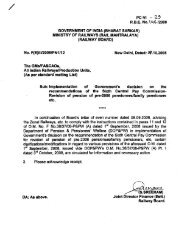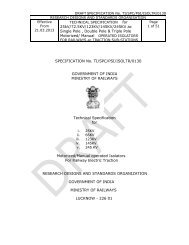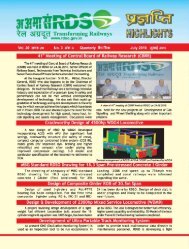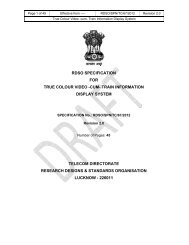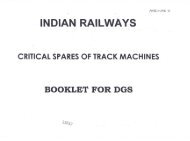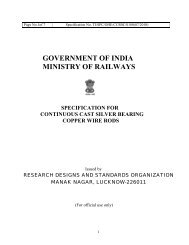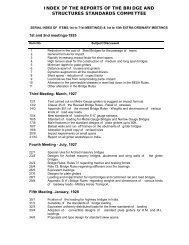Tender invited for Development of Train Collision Avoidance System
Tender invited for Development of Train Collision Avoidance System
Tender invited for Development of Train Collision Avoidance System
You also want an ePaper? Increase the reach of your titles
YUMPU automatically turns print PDFs into web optimized ePapers that Google loves.
ISO 9001: 2008 Effective from 18.06.2012 RDSO/SPN/196/2012 Version 3.1.1<br />
Document Title : Specification <strong>of</strong> <strong>Train</strong> <strong>Collision</strong> <strong>Avoidance</strong> <strong>System</strong><br />
<strong>of</strong> no acknowledgement from Loco Pilot within 5 seconds, Loco unit shall<br />
assume default train length as in Clause 5.6.2 and treat the train as new train.<br />
5.7 Types <strong>of</strong> Brake commands & Brake Interface Unit (BIU)<br />
5.7.1 TCAS shall be capable <strong>of</strong> giving following three levels <strong>of</strong> brake commands <strong>for</strong><br />
train braking:<br />
(i) Normal Brake (NB) command<br />
(ii) Full Service Brake (FSB) command<br />
(iii) Emergency Brake (EB) command<br />
5.7.2 In addition, TCAS shall also give additional command i.e. Loco Brake<br />
command in conjunction with Normal Brake / Full Service Brake / Emergency<br />
Brake, to develop BC pressure upto maximum value corresponding to loco<br />
independent brake if the train is identified as a Light Engine.The Brake<br />
Interface Unit (BIU) <strong>of</strong> Loco unit shall have following features:<br />
5.7.2.1 It shall apply normal, service & emergency brakes <strong>of</strong> locomotives<br />
respectively based on the type <strong>of</strong> brake command. In addition to these<br />
brakes, it shall also apply Loco brake, if Loco Brake command is received.<br />
5.7.2.2 It shall not reduce the braking level initiated by the Loco Pilot. However,<br />
TCAS can increase the level <strong>of</strong> braking over driver initiated braking as and<br />
when need arises.<br />
5.7.2.3 It shall not modify the existing braking characteristics <strong>of</strong> the locomotive<br />
(single/MU/Banking) as well as other self-propelled vehicles treated as<br />
train.<br />
5.7.2.4 It shall automatically cut <strong>of</strong>f traction/ regression shall take place at the<br />
instance <strong>of</strong> Loco unit initiated braking & traction shall be restored after<br />
withdrawal <strong>of</strong> Loco unit brake commands.<br />
5.7.2.5 It shall be possible to increase the extent <strong>of</strong> brake level (initiated by Loco<br />
unit) by the loco pilot, if he desires so.<br />
5.7.2.6 Whenever braking command is withdrawn by TCAS, the TCAS initiated<br />
brake shall release and loco pilot shall be able to restore traction.<br />
5.7.3 If RDSO developed and approved BIU is available, the same shall be used in<br />
place <strong>of</strong> the one described in 5.7.2. The interfacing to BIU shall be either<br />
through potential free contacts or through DC voltage.<br />
5.8 Automatic Brake Test (ABT) & Brake characteristics<br />
5.8.1 On <strong>for</strong>mation a new train, loco unit shall assume default brake characteristics<br />
<strong>of</strong> the train. The default brake characteristics shall be such that in the event <strong>of</strong><br />
perceived danger, the loco unit is able to stop train short <strong>of</strong> safe distance or<br />
control the speed to desired value be<strong>for</strong>e target, as the case may be.<br />
5.8.2 Whenever a train with default brake characteristics enters in block section,<br />
loco unit shall carryout Automatic Brake Test (ABT) to assess the correct<br />
brake characteristics <strong>of</strong> the train on a level track indicated through RFID tag.<br />
The ABT shall automatically take care <strong>of</strong> any Loco Pilot initiated braking<br />
including loco’s dynamic/ Rheostatic/ Regenerative brake during the course <strong>of</strong><br />
ABT, such that, it does not have impact on TCAS generated braking<br />
characteristics and TCAS meets its prime requirement <strong>of</strong> prevention <strong>of</strong><br />
collision.<br />
5.8.3 The outcome <strong>of</strong> the ABT shall be displayed on Loco Pilot’s OCIP in the <strong>for</strong>m<br />
<strong>of</strong> message ‘AUTO BRAKE TEST OK’ with audio alarm in case the ABT is<br />
considered successful by the loco unit.<br />
5.8.4 In case <strong>of</strong> failure <strong>of</strong> ABT to take place due to any reason, Loco unit shall<br />
per<strong>for</strong>m ABT again in the next block section.<br />
5.8.5 In case ABT is considered unsuccessful by Loco unit, ‘AUTO BRAKE TEST<br />
NOT OK’ shall be displayed on Loco Pilot’s OCIP alongwith audio alarm to<br />
alert Loco Pilot. However in such case, Loco unit shall retain the default brake<br />
characteristics & shall be able to stop short <strong>of</strong> safe distance limit or to control<br />
Signal Directorate RDSO/Lucknow Page 17 <strong>of</strong> 56



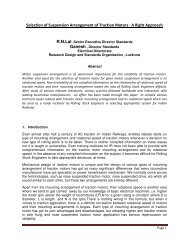

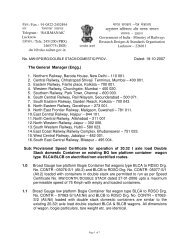
![Hkkjrljdkj] jsy ea= ky; vuql a/ kkuvfHkdYivkSj ekudlax Bu y ... - rdso](https://img.yumpu.com/21978459/1/184x260/hkkjrljdkj-jsy-ea-ky-vuql-a-kkuvfhkdyivksj-ekudlax-bu-y-rdso.jpg?quality=85)

